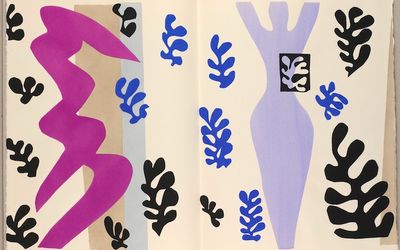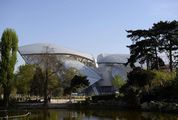Joburg to host Matisse exhibition in July
by Sue Blaine,
2016-01-25 20:25:59.0
WORKS by celebrated modernist Henri Matisse are coming to Johannesburg in an exhibition at the Standard Bank Gallery from July to September.
Henri Matisse: Rhythm and Meaning will be the gallery’s fourth showcasing of important international modernist work, the others having focused on Marc Chagall, Joan Miró, Pablo Picasso and 20th Century Masters. Born in France in 1869, Matisse is commonly regarded, along with Pablo Picasso and Marcel Duchamp, as one of the three artists who helped to define significant and sometimes revolutionary developments in art at the start of the 20th century.
"We are proud and excited to bring this exhibition (to Johannesburg)," said Standard Bank joint-CEO Ben Kruger. "It makes this significant master of the modern era accessible to more people, especially locally."
The exhibition will be the first solo exhibition for Matisse in Africa, says Patrice Deparpe, director of the Musée Matisse in Le Chateau Cambrésis, Matisse’s home town in northern France. "When we spoke about it for the first time I was surprised to discover that never before had there been a Matisse exhibition in Africa. That is so surprising because Africa is so important to Matisse."
During the early 1900s, the aesthetics of traditional African sculpture became a powerful influence among European artists including Matisse, who formed an avant-garde in the development of modern art, according to New York’s Metropolitan Museum of Art. Artists including Matisse and Picasso blended the highly stylised treatment of the human figure in African sculptures with painting styles derived from the post-Impressionist works of Cézanne and Gauguin. They were drawn to African sculpture because of its sophisticated approach to the abstraction of the human figure.
"Matisse is not just a French artist, (his work) has to travel — he belongs to the story of art," said Mr Deparpe. Mr Deparpe is co-curator with Federico Freschi, executive dean of the University of Johannesburg’s Faculty of Art, Design and Architecture.
"Why bring a European modernist to SA? The short answer is that Matisse is so fundamental to understanding modernist art," says Prof Freschi. "His work informed art making across race and continues to do so."
Works on show will range from pieces Matisse made as a student to pieces he created just before his death in 1954. These will include paintings, drawings, collages, prints and sculptures exploring the dominant themes of Matisse’s work. Most come from the Musée Matisse. The exhibition core will be the complete set of Jazz Prints, prepared from paper cut-outs during the Second World War and published in 1947.
Matisse turned to paper cut-outs when his health failed, leaving him unable to paint or sculpt. The cut-outs are some of his most recognised work and draw on themes from the circus, mythology and his own travels.
The exhibition will be accompanied by an extensive education programme, especially as Matisse’s work forms part of the school curriculum, said Mr Kruger. "The exhibition provides an invaluable opportunity for learners to enhance their knowledge by having a first-hand interaction with his work."
The educational programme comprises programmes for primary school children, high school pupils and the public. For primary schools, an interactive guide will be produced and university student tutors will lead workshops at selected schools; while groups of secondary school pupils will be brought to visit the exhibition and provided with workbooks, said Mr Kruger. For the public there will be free bi-weekly lectures and guided tours.
The bank is expecting large crowds. The other international exhibitions had brought in large numbers — 13,000 people came to see the Miró exhibition, 21,000 the 20th Century Masters, 22,000 Marc Chagall and 56,000 Picasso. A 2007 Matisse exhibition at London’s Tate Modern was the museum’s most successful exhibition to date, with about 500,000 people visiting.
"Presenting the Matisse Rhythm and Meaning exhibition is an even bigger coup in global city terms," said Mr Kruger. "It makes Johannesburg an important global cultural centre.... We are part of the global picture, even if we are a very small part if it."
The exhibition comes to SA through Standard Bank, the French Embassy to SA, the French Institute of SA and the Musée Matisse. Other sponsors are Air France, Total, and Air Liquide.
* Henri Matisse: Rhythm and Meaning, July 13 — September 17, Standard Bank Gallery, corner Simmonds St and Frederick St, Johannesburg.

Knife Thrower by Henri Matisse
WORKS by celebrated modernist Henri Matisse are coming to Johannesburg in an exhibition at the Standard Bank Gallery from July to September.
Henri Matisse: Rhythm and Meaning will be the gallery’s fourth showcasing of important international modernist work, the others having focused on Marc Chagall, Joan Miró, Pablo Picasso and 20th Century Masters. Born in France in 1869, Matisse is commonly regarded, along with Pablo Picasso and Marcel Duchamp, as one of the three artists who helped to define significant and sometimes revolutionary developments in art at the start of the 20th century.
"We are proud and excited to bring this exhibition (to Johannesburg)," said Standard Bank joint-CEO Ben Kruger. "It makes this significant master of the modern era accessible to more people, especially locally."
The exhibition will be the first solo exhibition for Matisse in Africa, says Patrice Deparpe, director of the Musée Matisse in Le Chateau Cambrésis, Matisse’s home town in northern France. "When we spoke about it for the first time I was surprised to discover that never before had there been a Matisse exhibition in Africa. That is so surprising because Africa is so important to Matisse."
During the early 1900s, the aesthetics of traditional African sculpture became a powerful influence among European artists including Matisse, who formed an avant-garde in the development of modern art, according to New York’s Metropolitan Museum of Art. Artists including Matisse and Picasso blended the highly stylised treatment of the human figure in African sculptures with painting styles derived from the post-Impressionist works of Cézanne and Gauguin. They were drawn to African sculpture because of its sophisticated approach to the abstraction of the human figure.
"Matisse is not just a French artist, (his work) has to travel — he belongs to the story of art," said Mr Deparpe. Mr Deparpe is co-curator with Federico Freschi, executive dean of the University of Johannesburg’s Faculty of Art, Design and Architecture.
"Why bring a European modernist to SA? The short answer is that Matisse is so fundamental to understanding modernist art," says Prof Freschi. "His work informed art making across race and continues to do so."
Works on show will range from pieces Matisse made as a student to pieces he created just before his death in 1954. These will include paintings, drawings, collages, prints and sculptures exploring the dominant themes of Matisse’s work. Most come from the Musée Matisse. The exhibition core will be the complete set of Jazz Prints, prepared from paper cut-outs during the Second World War and published in 1947.
Matisse turned to paper cut-outs when his health failed, leaving him unable to paint or sculpt. The cut-outs are some of his most recognised work and draw on themes from the circus, mythology and his own travels.
The exhibition will be accompanied by an extensive education programme, especially as Matisse’s work forms part of the school curriculum, said Mr Kruger. "The exhibition provides an invaluable opportunity for learners to enhance their knowledge by having a first-hand interaction with his work."
The educational programme comprises programmes for primary school children, high school pupils and the public. For primary schools, an interactive guide will be produced and university student tutors will lead workshops at selected schools; while groups of secondary school pupils will be brought to visit the exhibition and provided with workbooks, said Mr Kruger. For the public there will be free bi-weekly lectures and guided tours.
The bank is expecting large crowds. The other international exhibitions had brought in large numbers — 13,000 people came to see the Miró exhibition, 21,000 the 20th Century Masters, 22,000 Marc Chagall and 56,000 Picasso. A 2007 Matisse exhibition at London’s Tate Modern was the museum’s most successful exhibition to date, with about 500,000 people visiting.
"Presenting the Matisse Rhythm and Meaning exhibition is an even bigger coup in global city terms," said Mr Kruger. "It makes Johannesburg an important global cultural centre.... We are part of the global picture, even if we are a very small part if it."
The exhibition comes to SA through Standard Bank, the French Embassy to SA, the French Institute of SA and the Musée Matisse. Other sponsors are Air France, Total, and Air Liquide.
* Henri Matisse: Rhythm and Meaning, July 13 — September 17, Standard Bank Gallery, corner Simmonds St and Frederick St, Johannesburg.

















Change: 2.48%
Change: 2.53%
Change: 2.08%
Change: 1.97%
Change: 5.33%
Data supplied by Profile Data
Change: 0.00%
Change: 0.00%
Change: 2.48%
Change: 0.00%
Change: 0.00%
Data supplied by Profile Data
Change: 0.44%
Change: 0.11%
Change: -0.76%
Change: -0.92%
Change: -0.23%
Data supplied by Profile Data
Change: 0.00%
Change: 0.00%
Change: 0.00%
Change: 0.00%
Change: 0.00%
Data supplied by Profile Data